
Pellets to Burn
October 15, 2010
By
Scott Jamieson
John Arsenault drives around the country with the future of the pellet industry in the back of his SUV.
John Arsenault drives around the country with the future of the pellet industry in the back of his SUV. The vice-president of Energex Pellet Fuel Inc.’s Quebec operations keeps a 40-pound bag of torrefied pellets in his backseat, ready to show potential clients, politicians, or travelling biomass journalists what he, and many in the industry, feels to be the next generation of solid biomass fuels. The coal-like wood pellets are among several hundred pounds of pellets made in a pilot plant at the company’s facility in Lac-Mégantic, Quebec, near the border with rural Maine.
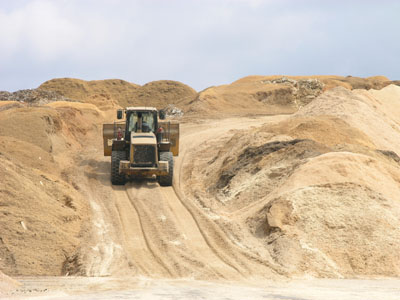
|
|
| A Caterpillar 972G moves raw fibre inventory around the yard. After the plant almost ran short of fibre during the boom winter of 2008–2009, Energex stocked up over the summer of 2009 and still has some inventory to carry into this winter. |
“There’s lots of talk about torrefied pellets, especially among academics,” the easy-talking industry veteran says from the plant parking lot. “But how many of us are driving around with 40-pound samples in their trucks? How many companies have made hundreds of pounds in a process that can be scaled up in a hurry? Maybe just us.”
That’s a fair point. There’s lots of talk around this dense, water-resistant solid biomass fuel, but little in the way of actual production. The Wood Pellet Association of Canada (WPAC) has a subcommittee looking at torrefaction technologies under the experienced eye of Len Fox, recently retired from Premium Pellets in Vanderhoof, British Columbia. Yet the initiative was launched just this past spring and is still in the engineering and feasibility stage. Some plants in Europe are making torrefied pellets, but there too, the process is in its infancy. That leaves Arsenault and his in-house process.
Hard Winter
Energex is a true pellet pioneer, having helped introduce the product to such current biomass giants as Sweden (see sidebar on page 21). Its current flagship plant in Lac-Mégantic was built by petroleum giant Shell in 1982 in response to the 1970s oil crisis. Designed to serve the industrial bulk market in the eastern United States, it ran as a Shell facility until 1993, when a group of private investors took it over. At that time, a few changes were made, including the addition of a bagging line and the move to sawmill residuals, allowing the plant to target the growing residential heating market.
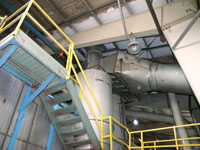
|
|
| The new cyclone and pneumatic systems were built from stainless steel by Rodrigue Metal. Like other systems, they vent outside to limit the consequences of any explosion. |
In 2000, the owners merged two U.S. pellet facilities into one larger facility in Mifflinton, Pennsylvania. That facility has since been modernized and expanded, finishing an upgrade in 2007. That same year, a green energy venture capital company out of Pennsylvania called DFJ Element acquired the majority of the company and has run the two plants since. The Lac-Mégantic and Mifflinton plants have annual capacities of 120,000 and 100,000 tonnes respectively. Both have similar horsepower, Arsenault explains, but the U.S. facility deals with hardwood. Either way, that makes the company a major player in the North American pellet sector.
Today, 95% of the Quebec plant’s production goes to the U.S. residential heating market, which, at times, can be a volatile place to do business.
“In the winter of 2008–2009, we couldn’t keep up. We almost ran out of supply, so our raw material costs went up and we took new sources like wood chips to add to our sawmill residues. Pellet costs went up as well, but with heating oil where it was, that was not a problem. Last summer, we stockpiled a lot of raw material to avoid running into shortfalls, but by November of 2009 we hit a wall. There was too much product out there, the winter was warm, and heating oil much cheaper, and we had to shut down production for much of the winter to balance things out.”
That harsh reality gave Arsenault time to accelerate a couple of projects. For starters, the collapse of the North American pellet market in November 2009 shocked more than just Energex. Few in the industry saw it coming. Yet looking back, Arsenault has uncovered a set of parameters that would have helped predict the collapse, had the industry known the signs.
“There are a number of factors, but it comes down to the price differential between heating oil and wood pellets at the end of the heating season. As homeowners, we look at our heating costs at the end of the year and either say, ‘I’ve got to do something about this,’ or not. In the summer of 2008, that difference was large enough to cause many homeowners to do something about it, and we had a great season in 2008–2009. We were so busy trying to keep up and raising prices that we didn’t realize what was happening. We were in the midst of a recession, heating oil prices had dropped dramatically, and pellet prices had gone up. The differential had vanished. Sales in the spring were still good because people were responding to a perceived shortage, so we didn’t notice the wall until we hit it hard in November.”
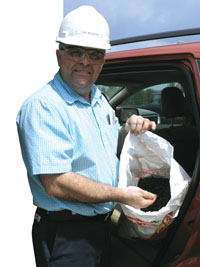
|
|
| John Arsenault, vice-president of Quebec operations, carries a sample of torrefied pellets in his back seat.
|
In fact, heating oil prices per litre (according to Statistics Canada) hit $1.29 in Montreal in July 2008, creating that massive gap. Just one year and a recession later, pricing had dropped to just over 71 cents/litre. This past July, heating oil prices in Montreal had climbed back to almost 87 cents/litre, setting the industry up for a better season this coming winter, or at least that’s what Arsenault is predicting.
“We’ll be able to test it out this year, but it seems that a heating oil price of at least 75 to 80 cents/litre, and thus a 15% differential, is a key factor. There are others—another really mild winter will hurt—but we’re expecting that demand will be significantly better this year. There is a lot of inventory out there, so pricing may not be great, but at least demand will be there.”
Generating a Future
Predicting poor markets is one thing; responding is another. That’s where Arsenault’s second project comes into play. Energex took advantage of its slow winter to push its pellet torrefaction development into high gear.
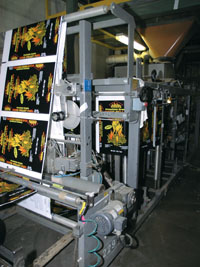 |
|
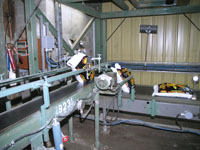 |
|
| The Premier-Tech bagging system, added in 2000, produces 23 to 24 bags/minute and helped reduce staffing significantly while almost doubling production. |
“It’s a question of necessity,” Arsenault explains. “It’s hard to invest in new technology and market development in ugly markets, but we can’t afford to wait, either as a company or an industry. Things like developing the market for residential heating are great, but it will take a long time to add any significant volumes. Let’s say we double it over the next 10 years to 120,000 tonnes in this area, there are two problems. We’re only adding 60,000 tonnes when more capacity than that has come into the market in Canada in the past year alone. And we’re taking 10 years to do it. We can’t survive another 10 years like this. We need to create a bang in the market, not a whimper.”
For a faster and larger bang, Arsenault and his colleagues at WPAC are targeting the coal-fired power generating industry in Canada. We’re a hydro-rich nation, but parts of the country still burn a lot of coal to meet peak demand. The country burns some 58 million tonnes of coal, with 51 million of it being used to generate power, chiefly in Alberta, Ontario, and Nova Scotia.
“You can see the attraction. If we can just achieve a 5% co-firing rate, we’d be creating a market for more pellets than are currently produced across all of Canada, just for this. That’s the kind of stability you need to grow this sector. And there is interest among Ontario Power Generation (OPG), and we’re starting to see interest among other utilities in other provinces.”
Arsenault and WPAC have been actively encouraging this issue as well, meeting with senate committees, federal ministry staff, provincial ministers, and, this fall, presenting at a power generator conference in Calgary, Alberta. It’s encouraging, but Arsenault cautions that the industry will need the right product to seal the deal.
“Wood pellets are a great solid fuel, but they have limitations. These utilities have large, open-air storage, which is fine with coal. Pellets on the other hand react poorly to water; 90% of my claims on the residential market are for moisture, and we ship those in bags. They don’t necessarily grind well using the utility’s equipment, and the energy content is much lower. Anything we can do to solve those problems makes us a better supplier and makes the decision for these power generators easier. That’s where torrefied pellets come in.”
Energex has developed a process to torrefy its own pellets that fits its existing production process without adding significant costs. Starting out in the company’s quality control lab, the process has moved to a small pilot plant that is filling 40-pound bags and, according to Arsenault, is ready to ramp up over the next year to production scale.
“It’s an in-house process we’ve been playing with over the past few years, but this past winter gave us the time to ensure we had a process that could be scaled up. And that’s what we need to do. As part of its investigative process, OPG, along with some American power generators, has contracted the Centre for Energy Advancement through Technical Innovation (CEATI) to test the merits of torrefied pellets as a renewable fuel. We’ve supplied a 40-pound bag for lab tests and will soon ramp up to larger samples.”
Arsenault expects to send a 50-tonne sample in the fall, hopefully followed by a 5,000-tonne sample in the early spring of 2011. “And we have others interested to hear about that first 5,000-tonne shipment. That’ll give them proof it can be done on a larger scale, making it a credible fuel supply.”
Arsenault is confident that the new fuel can be made cost effectively on an industrial scale. The goal is to have 100% of the plant’s production leave in torrefied form, and he stresses that this is possible in large part because the process was designed from a pellet producer’s perspective. For starters, the gas created in the torrefaction process will be re-used in the plant’s burner, thus limiting the effect on the plant’s energy balance.
“We’re not approaching this from a researcher’s perspective; we don’t want to wait for the perfect superpellet. We need to develop this from an industrial pellet producer’s point of view, with the client’s real needs in mind. One example is how far to take the process. Do we really need the 10,000-BTU/pound, super-dark pellet some researchers are talking about or making in labs? Sure they have impressive numbers on paper, but you lose a lot of mass in the process, so unless you’re capturing that gas on site there’s a big loss. And they become brittle, creating more dust than we want. In the real world, the advantages of a 10,000-plus BTU pellet gets shot down by the drawbacks and costs. What we’re making here is only 9,000 BTU, but that’s a lot better than the standard pellet’s 8,000 BTU/pound, and it’s waterproof, grindable into a fine dust, shippable, durable. For our process and 80% of the pellet plants in North America, it’s a better compromise, and one we think we can start delivering in the next year. ”
Canadian Biomass will keep an eye on Energex and the development of the industrial torrefied pellet over the coming 18 months. With luck, we’ll be reporting on the first industrial shipments sometime in 2011.
Market Ironies
Energex’ John Arsenault likes to tell a short tale to highlight the ironies of a pellet pioneer nation like Canada in desperate need of a market.
“In the early 1990s, Sweden enacted a carbon tax to reduce the nation’s dependence on fossil fuels. It’s a dreaded concept here, but the results are interesting. The power generators looked around for alternatives to avoid paying the tax and came across the idea of wood pellets.”
There were no wood pellet producers in Sweden making the volumes needed for industrial trials, so the generators imported pellets for a co-firing trial, which was a success. They then approached local sawmills, encouraging them to produce pellets from sawmill residuals, creating the industry from scratch. With further government incentives, a residential heating market also grew.
“Now Sweden burns more renewable fuels than fossil fuels, a stunning success in less than 20 years, and they are now the largest consumer and producer of wood pellets. The irony? Those first loads of pellets for the co-firing test came from this plant. We shipped two loads of 5,000 tonnes each in 1991 to help get the whole thing started, and we still can’t find a market here!”
| Safety Leader It has been almost 30 years since Shell built the Energex pellet plant in Lac-Mégantic, Quebec, yet the oil company’s fingerprints are still visible. Although the pellet industry continues to struggle with fire and explosion safety issues to this day, Shell seemed to have the answer back in 1982: build the plant as if it were an oil refinery. The plant was built to accept a wide range of raw materials, which has allowed Energex to move from almost 100% sawdust to a mixed diet in recent years. After sampling for both moisture and ash, the raw material goes to either a storage silo in the case of rare dry material, or more often to storage and then into the plant via Cat or Komatsu wheel loaders. The processing equipment can handle anything up to four inches in size, and indeed, the stockpiles include sawmill trim ends, among other material. The plant can store up to 5,000 tonnes in covered storage on site, thanks to its original industrial customer base. Cooled pellets are sent here or to the bagging line. The original bagger line, added in 1993 to enter the residential market, required eight workers per shift to bag 80 tonnes. The existing line, added in 2000, needs just two workers to bag 150 tonnes. It features a Premier-Tech bagger working at 23 to 24 bags/minute, a Faiveley automatic palletizer, and a Muller five-sided stretch hood system for climate protection. |
Print this page
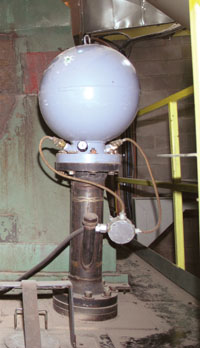 “You’ll see details here that you won’t find in other pellet plants,” John Arsenault explains while touring the fibre processing area. Pointing to what looks like a 1970s science project, he continues. “We have explosion detection systems like that in areas of the plant at risk, like dry fibre bins, grinders. We have Flamex spark detection systems of course, but these are different. They detect the slightest increase in pressure and immediately react with Halon or another inert gas. We’re processing a fuel here, and Shell built accordingly. Explosions will happen; we know that from experience. Here, they are contained with minimal damage.”
“You’ll see details here that you won’t find in other pellet plants,” John Arsenault explains while touring the fibre processing area. Pointing to what looks like a 1970s science project, he continues. “We have explosion detection systems like that in areas of the plant at risk, like dry fibre bins, grinders. We have Flamex spark detection systems of course, but these are different. They detect the slightest increase in pressure and immediately react with Halon or another inert gas. We’re processing a fuel here, and Shell built accordingly. Explosions will happen; we know that from experience. Here, they are contained with minimal damage.”